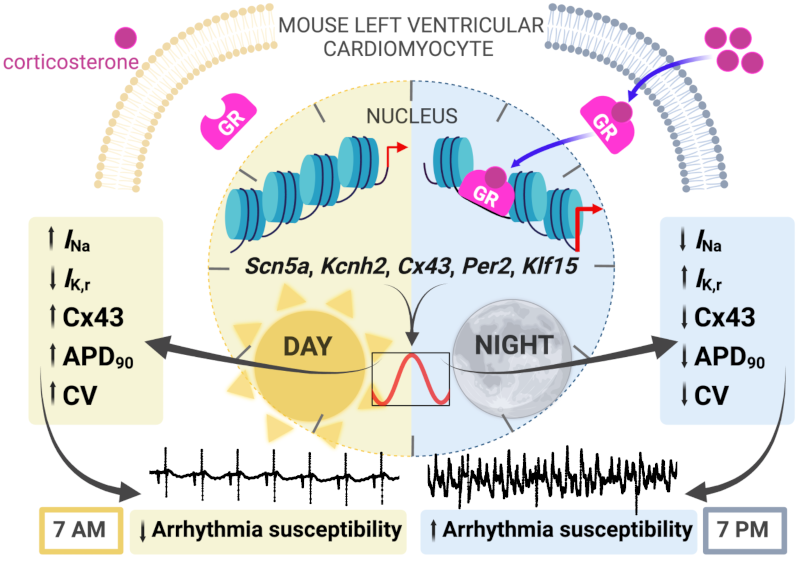GLUCOCORTICOID RECEPTOR REGULATES DIURNAL SUSCEPTIBILITY TO VENTRICULAR ARRHYTHMIAS BY A MECHANISM INVOLVING EPIGENETIC REGULATION OF ION CHANNELS EXPRESSION
Many studies have shown that potentially lethal heart rhythm disturbances, such as ventricular tachycardia and fibrillation tend to occur in the morning upon awakening, but the mechanisms underlying circadian variation of arrhythmia susceptibility was unexplored.
This study led by the group lead by Alicia D’Souza at the Imperial College London in collaboration with the IGF group “Cardioprotection, Physiopathology of Heart Rhythm and Ischemia” led by Matteo Mangoni has unravelled an unexpected role of the stress hormone cortisol, which peaks in the bloodstream, first thing in the morning. The study shows that at the beginning of subjective active period (light-off in mice, early morning in humans) the surge of cortisol induces transfer of its receptor (GR) in the nucleus. Binding of GR to chromatin induces up-regulation of expression of ERG1 K+ channels underlying the cardiac delayed rectifier K+ current (IK,r) and concomitant down-regulation of the fast Na+ current (INa) underling the upstroke phase of ventricular action potential and of connexin43 (Cx43), which ensures electrical conduction between ventricular myocytes. Numerical modelling work included in the article points to an effect of favoring re-entrant circuits in the ventricle, leading to increased propensity to arrhythmia. Interestingly, this diurnal regulation of chromatin accessibility to transcription factors by GR appears to be independent from classical genes involved in cellular clocks, such as Per2 and Klf15, even if it is highly likely that those genes “prime” chromatin to GR binding just before beginning of active period and the surge in circulating cortisol. Overall this study, which is part of the scientific program of the Fondation Leducq FANTASY Network coordinated by Matteo Mangoni, is the first to link diurnal regulation of ion channels expression to potentially lethal arrhythmias by an epigenetic modulatory mechanism.
This study has just been accepted for publication in Circulation Research and has been highlighted by an Editorial.

Schematic diagram of the action of corticoids and extracellular (left panel) or activated receptor (GR) bound to chromatin (right panel) in diurnal control of expression of ion channels and Cx43 at day and night (mouse active phase) and its link to susceptibility to ventricular arrhythmia. Arrows indicate the sense of variation in gene expression, leading to normal (left panel) or arrhythmic EGC tracing. Abbreviations : Scn5a (Nav1.5 channel), Kcnh2 (ERG1), APD90 (duration of ventricular action potential at 90% of repolarisation phase), CV (ventricular refractory period).


